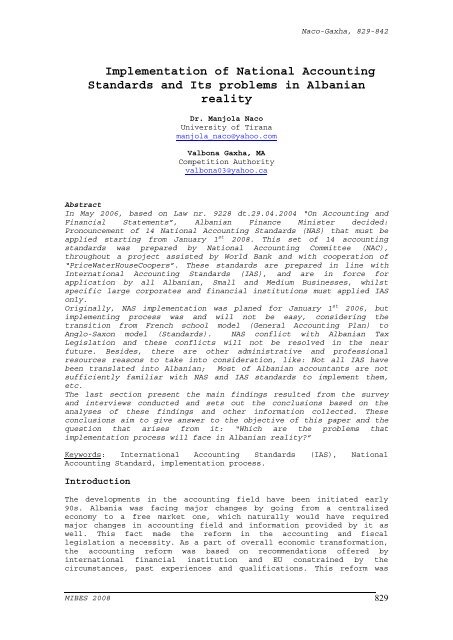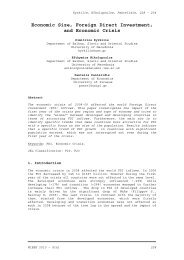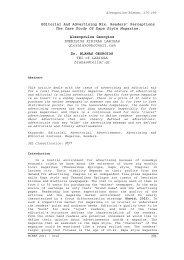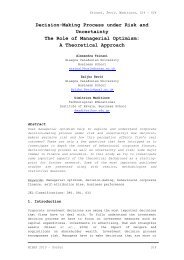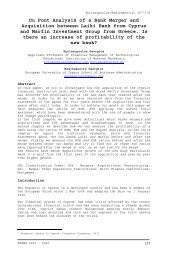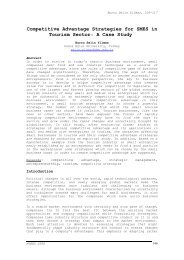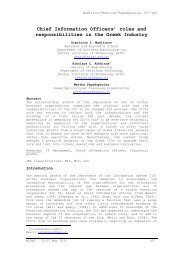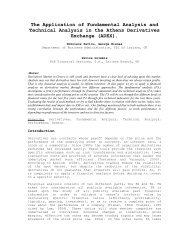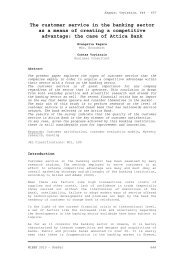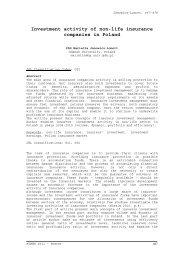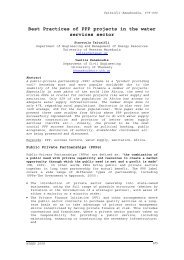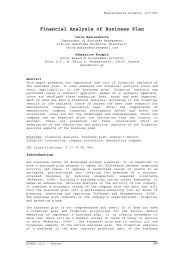Naco M., Gaxha V., Implementation of National Accounting ... - mibes
Naco M., Gaxha V., Implementation of National Accounting ... - mibes
Naco M., Gaxha V., Implementation of National Accounting ... - mibes
Create successful ePaper yourself
Turn your PDF publications into a flip-book with our unique Google optimized e-Paper software.
<strong>Naco</strong>-<strong>Gaxha</strong>, 829-842<br />
<strong>Implementation</strong> <strong>of</strong> <strong>National</strong> <strong>Accounting</strong><br />
Standards and Its problems in Albanian<br />
reality<br />
Dr. Manjola <strong>Naco</strong><br />
University <strong>of</strong> Tirana<br />
manjola_naco@yahoo.com<br />
Valbona <strong>Gaxha</strong>, MA<br />
Competition Authority<br />
valbona03@yahoo.ca<br />
Abstract<br />
In May 2006, based on Law nr. 9228 dt.29.04.2004 “On <strong>Accounting</strong> and<br />
Financial Statements”, Albanian Finance Minister decided:<br />
Pronouncement <strong>of</strong> 14 <strong>National</strong> <strong>Accounting</strong> Standards (NAS) that must be<br />
applied starting from January 1 st 2008. This set <strong>of</strong> 14 accounting<br />
standards was prepared by <strong>National</strong> <strong>Accounting</strong> Committee (NAC),<br />
throughout a project assisted by World Bank and with cooperation <strong>of</strong><br />
“PriceWaterHouseCoopers”. These standards are prepared in line with<br />
International <strong>Accounting</strong> Standards (IAS), and are in force for<br />
application by all Albanian, Small and Medium Businesses, whilst<br />
specific large corporates and financial institutions must applied IAS<br />
only.<br />
Originally, NAS implementation was planed for January 1 st 2006, but<br />
implementing process was and will not be easy, considering the<br />
transition from French school model (General <strong>Accounting</strong> Plan) to<br />
Anglo-Saxon model (Standards). NAS conflict with Albanian Tax<br />
Legislation and these conflicts will not be resolved in the near<br />
future. Besides, there are other administrative and pr<strong>of</strong>essional<br />
resources reasons to take into consideration, like: Not all IAS have<br />
been translated into Albanian; Most <strong>of</strong> Albanian accountants are not<br />
sufficiently familiar with NAS and IAS standards to implement them,<br />
etc.<br />
The last section present the main findings resulted from the survey<br />
and interviews conducted and sets out the conclusions based on the<br />
analyses <strong>of</strong> these findings and other information collected. These<br />
conclusions aim to give answer to the objective <strong>of</strong> this paper and the<br />
question that arises from it: “Which are the problems that<br />
implementation process will face in Albanian reality?”<br />
Keywords: International <strong>Accounting</strong> Standards (IAS), <strong>National</strong><br />
<strong>Accounting</strong> Standard, implementation process.<br />
Introduction<br />
The developments in the accounting field have been initiated early<br />
90s. Albania was facing major changes by going from a centralized<br />
economy to a free market one, which naturally would have required<br />
major changes in accounting field and information provided by it as<br />
well. This fact made the reform in the accounting and fiscal<br />
legislation a necessity. As a part <strong>of</strong> overall economic transformation,<br />
the accounting reform was based on recommendations <strong>of</strong>fered by<br />
international financial institution and EU constrained by the<br />
circumstances, past experiences and qualifications. This reform was<br />
MIBES 2008 829
<strong>Naco</strong>-<strong>Gaxha</strong>, 829-842<br />
very crucial considering the need <strong>of</strong> all economic sectors and<br />
government, for accurate and reliable information, as a key factor for<br />
their decision making process. The main objective <strong>of</strong> the reform was<br />
the adaptation <strong>of</strong> a new accounting system on the light <strong>of</strong> the drastic<br />
changes that were happening in Albania.<br />
However, besides the efforts, during this period, a lot <strong>of</strong> problems<br />
and issues were identified in both legislation and regulation<br />
framework: Law 7661 date 19.01.1993 “For <strong>Accounting</strong>” was not in line<br />
with International <strong>Accounting</strong> Standards; Law “For <strong>Accounting</strong>” and Law<br />
“For Commercial Entities” were written on the same time without having<br />
the possibility for coordination and harmonization <strong>of</strong> rules applied by<br />
both laws. Application <strong>of</strong> an <strong>Accounting</strong> Legislation, far from<br />
International Standards, brought up problems for foreign investors for<br />
the consolidation <strong>of</strong> their financial statements, etc.<br />
In order to address the shortcomings in the previous law, a new<br />
accounting law was enacted in 2004. So, the <strong>Accounting</strong> Law (1993).<br />
Complemented by General <strong>Accounting</strong> Plan which provided detailed<br />
guidance for all business entities in Albania was repealed when the<br />
new Law on <strong>Accounting</strong> and Financial Statements (2004) became effective<br />
on January 1 st, 2006. However, as a lot <strong>of</strong> delays happened, like: the<br />
translation process finished only end <strong>of</strong> 2006, just before the date<br />
set up for implementation, the pr<strong>of</strong>essionals involved in the process<br />
and moreover the government and public institutions were not prepared<br />
to start and assist the implementation process. In these conditions<br />
was decided to postpone the implementation date until January 1 st ,<br />
2008. This decision for postponement was the first signal that the<br />
implementation process was not going to be a smooth one.<br />
Referring to different studies and cases, we find that exist two<br />
different positions held by researches whilst analyzing this kind <strong>of</strong><br />
process. So, Cheney, (2002), draw attention to the fact that, in many<br />
countries within the EU, especially those countries with a local GAAP<br />
that is not particularly developed or where it quickly adjusts to<br />
international standards, will have no difficulties to prepare<br />
consolidated statements in accordance with IAS. In the other hand,<br />
Wilson (2001) believes that IAS implementation problem will be huge<br />
for many European companies. This is because Europe is embracing a<br />
future for financial reporting that is not necessarily that widely<br />
known or understood.<br />
In Albanian case, considering the basis <strong>of</strong> the old accounting system<br />
used, far from IAS principals, outdated in respond to the new economic<br />
development, not sufficient for the foreign investors interest, we<br />
believe that implementation process will have problems that need to be<br />
analyze.<br />
Methodology<br />
In order to give the reader the possibility to make his/her own<br />
judgement concerning the quality <strong>of</strong> the result (Gill & Johnson 1997),<br />
we will describe the method used.<br />
In this study, we have first compared the old accounting rules with<br />
new standards, and then analysed the consequences from different<br />
perspectives. Our approach, the abductive one, was neither to build up<br />
a new theory nor to test an existing one, as in induction and<br />
deduction. As the abductive approach is a combination <strong>of</strong> the deductive<br />
and the inductive approach (Alversson & Sköldberg, 1994), we started<br />
MIBES 2008 830
<strong>Naco</strong>-<strong>Gaxha</strong>, 829-842<br />
with the comparison between the accounting standards, got ideas for<br />
theory, and then went back to the empirical findings for further<br />
analyses.<br />
Regarding the collection <strong>of</strong> empirical data, as referring from the<br />
literature, there are two different research methods, quantitative and<br />
qualitative (Merriam, 1988). The qualitative method is harder to<br />
define than the quantitative. When applying the qualitative research<br />
the aim is to understand the significance <strong>of</strong> a particular phenomenon<br />
or experience. Based on this theory we have explored the differences<br />
between NAS and General <strong>Accounting</strong> Plan and the consequences <strong>of</strong> the<br />
implementation <strong>of</strong> these NAS, which is a qualitative approach. We<br />
explored NAS documents, General <strong>Accounting</strong> Plan manuals, the <strong>National</strong><br />
<strong>Accounting</strong> Standards, the IASB’s and the FASB’s accounting standards.<br />
The quantitative method focuses on the common, the average or the<br />
representative. The research objects must be able to be measured and<br />
the result must be able to be presented in numeric form (Eneroth,<br />
1984). In this frame, a postal questionnaire (Annex 1.), was prepared<br />
and sent out in order to collect empirical data. After designing the<br />
questionnaire, we consulted it with other colleges <strong>of</strong> accounting<br />
field, through interviews, in order to refine the questionnaire and<br />
later to check the reliability <strong>of</strong> the survey results and seek further<br />
explanation for some <strong>of</strong> the responses. Contacting a number <strong>of</strong> experts<br />
in the accounting field was considered from us as an important<br />
technique to make the project worthwhile.<br />
The questionnaire was sent out to 600 Approved Accountants (from 1300<br />
approved nationwide). Only 400 <strong>of</strong> them responded. However, the<br />
information collected was considered sufficient for statistical<br />
analysis purpose.<br />
Finally, all parts in theoretical frame <strong>of</strong> reference and the empirical<br />
findings where analysed and conclusions where drawn.<br />
A review on the old accounting system and its gaps<br />
Before the new accounting Law (2004), the basis <strong>of</strong> financial<br />
accounting and reporting in Albania was the old accounting Law(1993)<br />
complemented by a General <strong>Accounting</strong> Plan (GAP) which provided<br />
detailed guidance including a chart <strong>of</strong> accounts, outlined the<br />
applicable accounting and financial reporting requirements for all<br />
business entities in Albania.<br />
The old <strong>Accounting</strong> Law (1993) was based in French model where the<br />
state had a strong influence in the economy and fields related to it.<br />
It tended to protect the owners and creditors interests <strong>of</strong> the<br />
companies, organizing an accounting process oriented to fiscal<br />
purposes <strong>of</strong> the state and keeping national accounts.<br />
The main characteristics <strong>of</strong> GAP were:<br />
Income statement was expressed in more details, especially in the<br />
disclosure <strong>of</strong> categories <strong>of</strong> operating costs; GAP intended to require<br />
cost classification on the basis <strong>of</strong> the nature or the type <strong>of</strong><br />
expenditure and not according to the functions <strong>of</strong> the companies; there<br />
was no regulation about the consolidation <strong>of</strong> financial statements for<br />
group companies; did not provided a relevant regulation for special<br />
businesses like leasing and insurance companies; the translation <strong>of</strong><br />
current assets and liabilities in foreign currency was made by using<br />
balance sheet accounts and not P&L accounts; GAP did not anticipate<br />
MIBES 2008 831
<strong>Naco</strong>-<strong>Gaxha</strong>, 829-842<br />
the treatment <strong>of</strong> the differences from the change <strong>of</strong> accounting methods<br />
and accounting measurements; the treatment <strong>of</strong> construction contracts<br />
and the treatment <strong>of</strong> deferred taxation did not exist; the evaluation<br />
<strong>of</strong> tangible fixed assets was always a government decisions and not<br />
according the useful life <strong>of</strong> them.<br />
All these brought up the general conclusion that this model is too<br />
centralized, and does not give flexibility and freedom for judgment in<br />
preparing financial statements, creating so, the conditions for the<br />
new law to take place. So, Law 9228 “For <strong>Accounting</strong> and Financial<br />
Statements” was finalized after 2 years <strong>of</strong> work (2004).<br />
Based on this new law GAP had to be replaced by <strong>National</strong> <strong>Accounting</strong><br />
Standards (NAS). Then started the process <strong>of</strong> writing the <strong>National</strong><br />
<strong>Accounting</strong> Standards as a responsibility <strong>of</strong> <strong>National</strong> <strong>Accounting</strong><br />
Committee (NAC), a process that finished only by the end <strong>of</strong> year 2006.<br />
Meantime, the translation and publication <strong>of</strong> International <strong>Accounting</strong><br />
Standards starts.<br />
Now, we are at the moment that fourteen NAS 1 are approved and in force<br />
since January 1 st , 2008. They must be used by small and medium<br />
companies while, IAS and IFRS must be applied only by financial and<br />
banking institutions even though are not fully translated and<br />
published in Albanian yet.<br />
The graph below summarizes the phases that accounting reform has been<br />
through:<br />
Albanian <strong>Accounting</strong> Reform: 1993 1994 1995 1996 1997 1998 1999 2000 2001 2002 2003 2004 2005 2006 2007 2008<br />
<strong>Accounting</strong> Reform<br />
Law "For <strong>Accounting</strong>" approved<br />
<strong>National</strong> <strong>Accounting</strong> Council:<br />
from establishment to full function<br />
Time for the harmonisation with IAS<br />
and preparation <strong>of</strong> the changes<br />
Law "For the accounting and financial<br />
Statement"<br />
<strong>National</strong> <strong>Accounting</strong> Standards:<br />
from writing to publication<br />
International <strong>Accounting</strong> Standards:<br />
Start o translation process<br />
Graph 1: <strong>Accounting</strong> System developments 1993- 2008.<br />
1<br />
NAS 1 General Frame for preparation <strong>of</strong> Financial Statements; NAS 2 Presentation <strong>of</strong><br />
Financial Statements, Changes in <strong>Accounting</strong> Estimates and Errors ; NAS 3 Financial<br />
Instruments; NAS 4 Inventories; NAS 5 Property, Plant and Equipment, Intangible Assets,<br />
Impairment <strong>of</strong> Assets; NAS 6 Provisions; NAS 7 Financial Lease; NAS 8 Revenue<br />
NAS 9 Business Combination; NAS 10 <strong>Accounting</strong> for Government Grants and Disclosure <strong>of</strong><br />
Government Assistance; NAS 11 Income Taxes; NAS 12 The Effects <strong>of</strong> Changes in Foreign<br />
Exchange Rates; NAS 13 Agriculture; NAS 14 Consolidated and Separate Financial<br />
Statements, Investments in Associates.<br />
MIBES 2008 832
<strong>Naco</strong>-<strong>Gaxha</strong>, 829-842<br />
Comparison between NAS and General <strong>Accounting</strong> Plan<br />
In this part we will try to give briefly the difference between the<br />
accounting treatments required by these 14 new Standards versus the<br />
General <strong>Accounting</strong> Plan. These differences would affect significantly<br />
in preparation <strong>of</strong> the financial statements and the financial reporting<br />
and will the bases for explaining the problems and difficulties which<br />
the accountants would face during this implementation process. We<br />
classified these differences/ changes into:<br />
Totally new requirements 9, 14<br />
Major Change in <strong>Accounting</strong> 1, 3, 5, 6, 7, 10<br />
Principles<br />
Minor Change in <strong>Accounting</strong> 4, 11, 12, 13<br />
Principles<br />
Only Change in Disclosure 2, 8<br />
According to Wilson (2001) and H<strong>of</strong>ste (2002) it is <strong>of</strong> interest to<br />
assess the materiality <strong>of</strong> the changes in accounting principles when<br />
analysing the effect <strong>of</strong> implementation <strong>of</strong> new standards. So, we<br />
explain only the major changes listed above:<br />
The financial reporting requires preparation <strong>of</strong> additional statements<br />
or additions in the existing one, like: Cash Flow, Equity statement.<br />
In the Balance Sheet, the standards require some changes as well: the<br />
deferred taxes liability, should be treated in the new standards; the<br />
provisions and the subventions should be included as part <strong>of</strong> the<br />
liabilities; the purchase <strong>of</strong> own shares is classified as a regulation<br />
<strong>of</strong> the Equity and can be shown as a reduction <strong>of</strong> the Equity, while in<br />
GAP the purchase <strong>of</strong> own shares was classified as assets. Also changes<br />
are brought up in relation to the presentation <strong>of</strong> the periods earnings<br />
which is not shown anymore as an alone element but aggregated to the<br />
retained earnings.<br />
In the Income Statement, the entity should present an analysis <strong>of</strong> the<br />
expenses either by type or by its function and not as a combination <strong>of</strong><br />
the two, while GAP required it only by the type <strong>of</strong> the expenses.<br />
The Cash Flow Statement, as another required statement, based on the<br />
new <strong>Accounting</strong> Law, is now supported by detailed instructions for its<br />
preparation compared to GAP that had any. In this part, NAS<br />
requirements are the same as <strong>of</strong> the international financial reporting<br />
standards (IFRS).<br />
The Equity Statement, as a statement that shows the actions <strong>of</strong> the<br />
owners with their Equity, the movements <strong>of</strong> the accumulated earnings<br />
and all the components <strong>of</strong> Equity is now required to be shown as a<br />
primary statement. Again, in this part the standards requirements are<br />
in line with international financial reporting standards (IFRS).<br />
Disclosures are totally adapted to all the requirements <strong>of</strong> the<br />
International Financial Reporting Standards (IFRS).<br />
Financial Instruments (NAS 3) defines concepts that were not treated<br />
before, like derivatives. This standard requires the use <strong>of</strong> effective<br />
interest rate and discounted cash flow concept.<br />
MIBES 2008 833
<strong>Naco</strong>-<strong>Gaxha</strong>, 829-842<br />
The tangible fixed assets (TFA) and intangibles (IFA), their<br />
recognition and the measures (including the reassessments) are subject<br />
to NAS 5. The important change, especially for the Albanian reality<br />
asset, (the documentation problems <strong>of</strong> the property recognition),<br />
according to the standard the assets are recognized when the<br />
recognition criteria are fulfilled, which means that is possible that<br />
any economical future gain regarding this asset can come in or go out.<br />
The difference in the treatment <strong>of</strong> the expenses <strong>of</strong> research and<br />
development according to the NAS they generally cannot be capitalized<br />
while according to the old treatment they usually are capitalized.<br />
The depreciation <strong>of</strong> TFA and IFA should be done systematically along<br />
the useful life <strong>of</strong> the assets, in contrast to the old treatment where<br />
IFA are depreciated within a period <strong>of</strong> at maximum 5 years, while for<br />
TFA were applied the quotas approved by the Ministry <strong>of</strong> Finance.<br />
According to the old law the reassessment <strong>of</strong> the tangible assets could<br />
be done only with a special decision <strong>of</strong> the Government. The new<br />
standards require to be assessed at the end <strong>of</strong> every period as well.<br />
The debt cost capitalization starts when expenses and debts happen<br />
because <strong>of</strong> the asset creation, and when the activities regarding the<br />
preparation <strong>of</strong> an asset for the use or to be sold are ongoing. In the<br />
previous treatment these costs were not capitalized.<br />
The fixed assets that are kept for sale were not treated in GAP, now<br />
should be classified as ‘hold for sale’ when: their book value will be<br />
recuperated mainly through the sale and not through its continuous<br />
use; the asset is ready to be sold in its current state;<br />
Provisions and the ascertained Liabilities should be recognized only<br />
when: an economic entity has a current liability to pass the economic<br />
gains that come from past events; exists the possibility that this<br />
passing can be needed to liquidate a liability; and can be made<br />
credible calculations <strong>of</strong> the liability amount.<br />
Regarding the income taxes (including the current and deferred and the<br />
dividends taxes) the measure <strong>of</strong> the deferred tax liabilities and<br />
deferred tax assets should reflect the taxable consequences that will<br />
result from the way that the economic entity expects to recuperate or<br />
liquidate the assets or liabilities amount on the exercise period<br />
closure date.<br />
NAS implementation process<br />
As noted previously, the major changes were explained in order to<br />
measure the materiality <strong>of</strong> the system changes effect, which leads us<br />
to the next matter to be analyzed: implementation <strong>of</strong> these standards.<br />
According to Dennis (1999), once the information is gathered about<br />
effects in various areas, accountants should try to understand the<br />
standard’s impact.<br />
A concern is whether the necessary knowledge in order to comply with<br />
these standards is available or not and if yes, at what level?<br />
Following this concern the surveys’ data were processed and analyzed.<br />
As presented in the methodology part, the data collected from the<br />
survey filled out and returned only by 400 approved accountants (600<br />
distributed) were processed and analyzed excluding the ones that were<br />
not completed or gave confusing answers.<br />
MIBES 2008 834
<strong>Naco</strong>-<strong>Gaxha</strong>, 829-842<br />
From these data resulted that the most part (Approx.50%) <strong>of</strong> the<br />
surveyed accountants had basic knowledge on new standards and the<br />
level <strong>of</strong> the knowledge varied at each individual standards level<br />
(Graph 3). Referring to graph 2 we can see that the lowest level <strong>of</strong><br />
knowledge is presented at standards that are considered completely new<br />
like NAS 14 and NAS 9, even though the answers at this last one are<br />
effected by the fact that part <strong>of</strong> the accountants interviewed worked<br />
for Banks or Financial institutions and already were familiar with<br />
consolidation process. However, it’s obvious the low level <strong>of</strong> good<br />
knowledge for other standards that are evaluated as major changes in<br />
accounting system like NAS3 and NAS 6. The “very good” level <strong>of</strong><br />
knowledge was presented at standards classified as minor changes like<br />
NAS 4 Inventories.<br />
Level <strong>of</strong> NAS knowledge<br />
100%<br />
90%<br />
80%<br />
Per cent a ge<br />
70%<br />
60%<br />
50%<br />
40%<br />
4 - Very Good<br />
3 - Good<br />
2 - Basic<br />
1 - No Information<br />
30%<br />
20%<br />
10%<br />
0%<br />
NAS 1 NAS 2 NAS 3 NAS 4 NAS 5 NAS 6 NAS 7 NAS 8 NAS 9<br />
NAS<br />
NAS<br />
NAS<br />
NAS<br />
NAS<br />
10<br />
11<br />
12<br />
13<br />
14<br />
Graph 2: Actual level <strong>of</strong> knowledge <strong>of</strong> each NAS by the accountants<br />
In order to further evaluate the difficulties that the accountants<br />
would face during the implementation process, so to evaluate how easy<br />
or hard this process would be in Albania we surveyed and analyzed the<br />
gap that resulted between the knowledge for each standards and the<br />
level <strong>of</strong> their applicability. Let’s look closely at Graph 3:<br />
Knowledge vs Level <strong>of</strong> Applicability <strong>of</strong> NAS<br />
400<br />
350<br />
300<br />
250<br />
200<br />
150<br />
100<br />
50<br />
0<br />
NAS 1 NAS 2 NAS 3 NAS 4 NAS 5 NAS 6 NAS 7 NAS 8 NAS 9 NAS 10 NAS 11 NAS 12 NAS 13 NAS 14<br />
Average Level <strong>of</strong> Knowledge<br />
Applicability<br />
Graph 3. Average Level <strong>of</strong> knowledge vs. Level <strong>of</strong> Aplicability <strong>of</strong> NAS<br />
MIBES 2008 835
<strong>Naco</strong>-<strong>Gaxha</strong>, 829-842<br />
Its clear that gap between knowledge and applicability is bigger at<br />
NAS 1, NAS 2, NAS 5, NAS 6, NAS 8, NAS 12. Considering that these<br />
standards are not only new or mostly new but widly applicaple so the<br />
lack <strong>of</strong> knowledge on these standards will have a big impact on the<br />
financial statment preparation process and reporting. So, we can say<br />
that the quality <strong>of</strong> this fiancial staments will depend on the level <strong>of</strong><br />
knowledge.<br />
As mentioned before, the group chosen for the survey was from the<br />
pr<strong>of</strong>essional accountants, which means that they have higher level <strong>of</strong><br />
expertise and knowledge compare to the accountants employed in medium<br />
and small firms. In this context, naturally we comment that the survey<br />
result indicates that the problems will be more aggravated if we go<br />
down to the simple accountants’ level.<br />
Also, the group that didn’t respond to the survey makes us believe<br />
that the process <strong>of</strong> NAS implementation will face the silent resistance<br />
<strong>of</strong> the old accountants’ generation, who has used the old accounting<br />
rules for a long time. So, familiarization with the new terminology,<br />
concepts and techniques like: fair market value, hedging accounting<br />
etc., will require not only reading but a long and throughout studies<br />
in special courses.<br />
However, since the reason for the change is due to amendment <strong>of</strong> the<br />
legislation, the implementation <strong>of</strong> NAS/IAS should not be met with<br />
resistance.<br />
Lack <strong>of</strong> knowledge can be so identified as the key problem. We are<br />
convinced that our accountants are not sufficiently well versed in<br />
national and international standards to implement them, with a few<br />
exceptions. This problem will require a strong private sector<br />
accounting organization and a wide training campaign leaded by them.<br />
There have been some efforts from accounting organizations that<br />
operate in Albania to organize trainings. But, not all <strong>of</strong> them have<br />
sufficient capacities/resources for this purpose. Only, Institute <strong>of</strong><br />
Approved Accountant was able to organize training sessions during<br />
2007. However, these trainings had two problems: they were focused<br />
only in theoretical treatment and explanation <strong>of</strong> NAS and not<br />
explaining practical or real cases and, low participation because <strong>of</strong> a<br />
relatively high cost <strong>of</strong> these trainings sessions.<br />
This conclusion is supported by the accountants themselves when 36% <strong>of</strong><br />
them (Graph 4) chosen the “insufficient guidance on first application”<br />
in answering the question: What difficulties are you experiencing in<br />
NAS and/or IAS application?<br />
Type <strong>of</strong> problems (accountants opinions)<br />
31%<br />
7% Insuficient giudance on first-time<br />
application<br />
36%<br />
The tax- driven nature <strong>of</strong><br />
accounting<br />
26%<br />
The complicated nature <strong>of</strong> these<br />
standards<br />
Other<br />
Graph 4: Type <strong>of</strong> problems the accountants think will face Survey<br />
question.<br />
MIBES 2008 836
<strong>Naco</strong>-<strong>Gaxha</strong>, 829-842<br />
Another interesting result was identification <strong>of</strong> “the tax-driven<br />
nature <strong>of</strong> accounting “as an old mentality inherit from past<br />
experience. An increasing number <strong>of</strong> large enterprises now recognize<br />
that the main audience for the financial statements they prepare are<br />
shareholders but, the smaller Albanian companies still think that<br />
accounting information is only for the tax authorities. This attitude<br />
is reinforced from Albanian tax authorities themselves, who <strong>of</strong>ten<br />
could not ask to see any financial statements based on accounting<br />
Standard. The Albanian tax rules are different from NAS, so why bother<br />
to look at financial statements that are prepared using NAS? They want<br />
to look only at statements prepared using fiscal rules.<br />
Explaining the value <strong>of</strong> the process and the benefits for the<br />
management. In Albania, till now, the only reason most firms prepared<br />
financial statements was to report to the tax authorities, hence the<br />
accounting was ruled by fiscal rules. The survey’s data collected show<br />
that a considerable number <strong>of</strong> surveed accountants think that must<br />
prepare same financial statements (graph 5). This position goes along<br />
with some managers’ mentality that pays attention only on fiscal<br />
reporting.<br />
Type <strong>of</strong> Financial Statements to be prepared<br />
Fiscal vs NAS<br />
20%<br />
Same financial and fiscal statm.<br />
Separate financial and fiscal statm.<br />
No answer<br />
20%<br />
60%<br />
Graph 5: Type <strong>of</strong> Financial statement to be prepared. Survey.<br />
The new Albanian business managers <strong>of</strong> small and medium companies are<br />
characterized by a negative attitude against the implementation <strong>of</strong><br />
NAS. This mentality consists at considering the change <strong>of</strong> the rules<br />
useless and not as a valuable source <strong>of</strong> information for the management<br />
process.<br />
The challenge is to fight this mentality <strong>of</strong> the owners and managers <strong>of</strong><br />
small and medium companies, in order to make them understand that NAS<br />
and IAS will help the companies to achieve superior information, hence<br />
to get better financing terms, Dumontier and Raffouriner (1998).<br />
In the end let’s mention an “external” factor that will have its<br />
effect in the process. Need for legislative harmonization is upcoming<br />
as there are some changes taking place in existing fiscal legislation<br />
as well. Considering that these changes consist in most cases in some<br />
definitions and partially in content <strong>of</strong> the terms used, the need for<br />
the harmonization <strong>of</strong> these changes with accounting standards need to<br />
be flagged. (For example: - the term „market value“ is used in the Law<br />
for <strong>Accounting</strong>, whilst the term „market price“ used in the Law for<br />
commercial entities).<br />
MIBES 2008 837
<strong>Naco</strong>-<strong>Gaxha</strong>, 829-842<br />
Conclusive summary<br />
The common argument that emerges from this paper is that a successful<br />
implementation <strong>of</strong> national standards will be a challenge for all<br />
stakeholders (accountants, academics, managers, policymakers).<br />
Fundamental to the implementation <strong>of</strong> new national accounting standards<br />
is a clear understanding <strong>of</strong> what these standards are, what they<br />
require and more over their impact in reporting process, businesses<br />
and investors.<br />
This process is like “a minesweeper game” and, in order to<br />
successfully finishing it, must find all the mines, otherwise you are<br />
lost. Change <strong>of</strong> the mentality towards a positive attitude against the<br />
accounting changes, raising awareness on the advantages and benefits<br />
<strong>of</strong> the process for the businesses itself, should be another focus<br />
during the process.<br />
Inconsistencies between NAS and Albanian fiscal framework must be<br />
solved in order to achieve a convergence between accounting law and<br />
fiscal laws in order to harmonize the terminology.<br />
The NAS implementation has started and for sure will be difficult for<br />
everyone involved however, is not a “mission impossible” if we all<br />
contribute by seeing ourselves as part <strong>of</strong> the process.<br />
References<br />
Law”On <strong>Accounting</strong> and Financial Statements” 2004,<br />
Blanc, L. (2003) International <strong>Accounting</strong> Standards - The impact on<br />
Your Business Systems Financials,<br />
Dumontier, P. and Raffouriner, B. (1998) Why Firms Comply with IAS:<br />
an Empirical Analysis with Swiss Data. Journal <strong>of</strong> International<br />
Financial Management and <strong>Accounting</strong>, 9(3).<br />
Cheney, G.(2002) The dream <strong>of</strong> a common language. Australian CPA;Issue<br />
2,<br />
Dennis, A.(1999) Translating the standards. Journal <strong>of</strong> Accountancy;<br />
Wilson, A. (2001) IAS: the challenge for management. Accountancy;<br />
December,<br />
Gill, J., Johnson, P.(1997) Research methods for managers. London<br />
H<strong>of</strong>ste, P.(2002) The revolution will be itemised, Financial World;<br />
February<br />
Karamanou, I. and Nishiotis, G. (2005) The Valuation <strong>of</strong> Firm<br />
Voluntary Adoption <strong>of</strong> International <strong>Accounting</strong> Standards. Working<br />
Paper, University <strong>of</strong> Cyprus<br />
Robert W. McGee, Galina G. Preobragenskaya, Problems <strong>of</strong> Implementing<br />
International <strong>Accounting</strong> Standards in a Transition Economy: A Case<br />
Study <strong>of</strong> Russia (2004).<br />
Local materials<br />
SKK, (2006). Nacional <strong>Accounting</strong> Standards Law 9228 “For <strong>Accounting</strong><br />
and Financial Statements” (2004) <strong>Accounting</strong> Law (1993) & General<br />
<strong>Accounting</strong> Plan<br />
MIBES 2008 838
<strong>Naco</strong>-<strong>Gaxha</strong>, 829-842<br />
Interviews<br />
Head <strong>of</strong> Finance and <strong>Accounting</strong> Departments, Managers and CEOs <strong>of</strong> the<br />
following companies :AMC, Vodafon, Tirana- Leasing, Raiffeisen –<br />
Leasing, Interalbanian, Sigma, Insig.<br />
Websites<br />
European Parliament (2002). Report on the proposal for a European<br />
Parliament and Council regulation on the application <strong>of</strong><br />
international accounting standards.<br />
FASB (Financial <strong>Accounting</strong> Standard Board), Website.<br />
IASB (International <strong>Accounting</strong> Standard Board), Website.<br />
MIBES 2008 839
<strong>Naco</strong>-<strong>Gaxha</strong>, 829-842<br />
Annex 1. Questionnaire<br />
Questionnaire<br />
Personal Information<br />
Name:<br />
Last Name:<br />
Age:<br />
Gender:<br />
Male<br />
Female<br />
City:<br />
How many years have you been in this Pr<strong>of</strong>ession?<br />
Company Information<br />
Industry:<br />
Production Merchandise Services Banking/Financial Sector<br />
Position within the Company:<br />
Management<br />
Consultancy<br />
Company size:<br />
Number <strong>of</strong> Employees:<br />
Total Income:<br />
Company Legal Form:<br />
Single Proprietorship Partnership Incorporated<br />
<strong>National</strong> <strong>Accounting</strong> Standards<br />
NAS<br />
Level <strong>of</strong> knowledge<br />
Effect on your Company's Financial<br />
Statements<br />
1 2 3 4 1 2 3 4<br />
1 NAS 1<br />
2 NAS 2<br />
3 NAS 3<br />
4 NAS 4<br />
5 NAS 5<br />
6 NAS 6<br />
7 NAS 7<br />
8 NAS 8<br />
9 NAS 9<br />
10 NAS 10<br />
11 NAS 11<br />
12 NAS 12<br />
13 NAS 13<br />
14 NAS 14<br />
MIBES 2008 840
<strong>Naco</strong>-<strong>Gaxha</strong>, 829-842<br />
International <strong>Accounting</strong> Standards<br />
IAS<br />
Level <strong>of</strong> knowledge<br />
Effect on your Company's Financial<br />
Statements<br />
1 2 3 4 1 2 3 4<br />
1 IAS 1<br />
2 IAS 2<br />
3 IAS 3<br />
4 IAS 4<br />
5 IAS 5<br />
6 IAS 6<br />
7 IAS 7<br />
8 IAS 8<br />
9 IAS 9<br />
10 IAS 10<br />
11 IAS 11<br />
12 IAS 12<br />
13 IAS 13<br />
14 IAS 14<br />
15 IAS 15<br />
16 IAS 16<br />
17 IAS 17<br />
18 IAS 18<br />
19 IAS 19<br />
20 IAS 20<br />
21 IAS 21<br />
22 IAS 22<br />
23 IAS 23<br />
24 IAS 24<br />
25 IAS 25<br />
26 SNK 26<br />
27 SNK 27<br />
28 SNK 28<br />
29 SNK 29<br />
30 SNK 30<br />
31 SNK 31<br />
32 SNK 32<br />
33 SNK 33<br />
34 SNK 34<br />
35 SNK 35<br />
36 SNK 36<br />
37 SNK 37<br />
38 SNK 38<br />
39 SNK 39<br />
40 SNK 40<br />
41 SNK 41 c<br />
MIBES 2008 841
<strong>Naco</strong>-<strong>Gaxha</strong>, 829-842<br />
What difficulties are you experiencing in NAS and/or IAS application?<br />
Insufficient Guidance on first-time application<br />
The tax-driven nature <strong>of</strong> the national accounting requirements<br />
The complicated nature <strong>of</strong> these standards<br />
Other (Please specify)<br />
Do you think that financial statements for tax purpose should be the same or separate from the ones prepared for financial reporting purpose?<br />
Same financial statements with outside adjustments<br />
Separate financial statements<br />
No answer<br />
MIBES 2008 842


